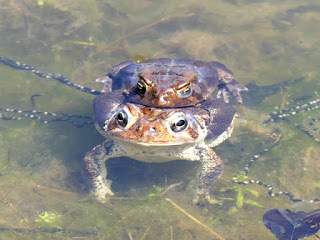Mating Toads
In yesterday's post I mentioned that I heard American Toads as they were advertising their availability (and perhaps desirability) during their mating season. Today's picture actually shows the toads while mating.
When I 1st saw the pair, I thought maybe I was seeing the same toad's face twice, once with it reflecting off the water. But upon closer inspection, the toad on the top is clearly smaller than the one on the bottom, and both heads are out of the water.
Among toads (and many turtles, and some raptors) the females are noticeably larger than the males, as is true in this case. And despite the closeness of this pair, most toad reproduction happens quite a bit differently than (for example) human reproduction. In most of our toad species (you can read about other varieties here) the female releases her eggs directly into the water, and the male (at approximately the same time and place) releases his sperm into the water, hopefully resulting in many of those eggs being fertilized [1].
While many frog eggs are seen in clumps, our toads tend to lay eggs in strings, sometimes likened to beads. In fact, I'm highly suspicious that those black-and-white stringy strands floating nearby are the female's eggs. (I suspect it's impossible to tell whether they've been fertilized at this point, though presumably will be.)
Since American Toad eggs are normally black, I'm not sure what caused the white part of the strands. This article suggests that albino or leucistic toads will produce white eggs. I suppose that if the female toad had 1 (recessive) albino gene, maybe she would produce a mix of both black and white eggs. The main problem with this theory is that I'd expect a "half-albino" female toad to produce approximately a 50-50 mix of black and white eggs, and I'm not sure there's enough white for this explanation to be accurate [2].
In any event, if all goes well this courtship will result in little toadlets.
 |
| April 14, 2023 at Sourland Mountain Preserve Photo 272127688, (c) jpviolette, some rights reserved (CC BY-NC) |
[1] My guess is that with this form of reproduction where eggs and sperm need to encounter each other in a body of water, some unlucky eggs never get fertilized. Since we still have toads, it's apparent that many of the eggs do get fertilized.
[2] I'm also unsure how many albino/leucistic genes are in our wild toad populations. If it's 1 in 50, this explanation seems more likely that if the odds of finding such a toad are 1 in 10,000.



Comments
Post a Comment